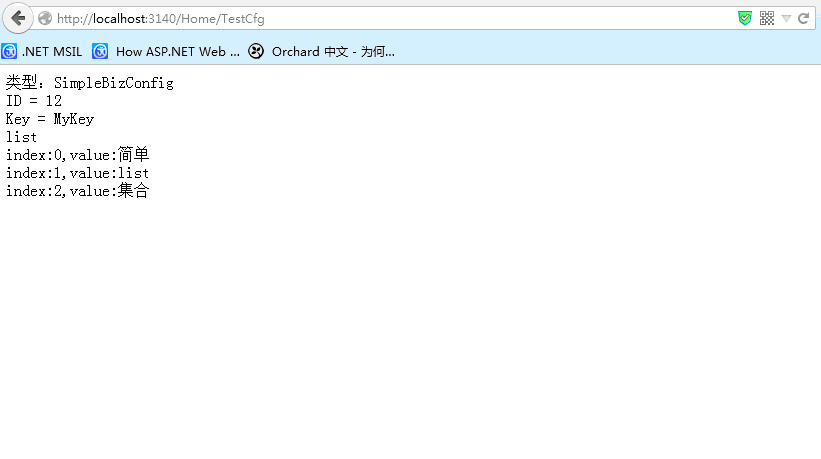
·您现在的位置: 云翼网络 >> 文章中心 >> 网站建设 >> 网站建设开发 >> ASP.NET网站开发 >> 利用XML序列化和Asp.Net Web缓存实现站点配置文件
- 在Web Service中使用ASP.net状态保持
- 母版页中ContentPlaceHolder 控件的作用
- asp.net 页面上传文件控件后台代码Request.Files获取不到
- ASP.Net中防止页面刷新重复提交的几种方法
- 多个提高C#编程能力的建议
- AJAX在线音乐网站(1)需求和功能结构
- Winform上传下载文件代码
- 使用Obsolete特性来标记方法过时或弃用
- ASP.NET 如何做出简单的验证码
- 系统权限的设计之简单设计
- [视频教程]Visual.Studio2005视频教程16.Crystal Report篇之概述
- MVC MODEL Attribute 操纵速记
- asp.net 生成图片验证码
- C#零基础入门04:打老鼠初级之枚举、重构、事件处理器
- 【转载】HTTP 错误 500.19
- 带阴历显示的日期
- 提升jQuery开发技能的教程
- ADO.NET实用技巧两则
- 为ASP.NET应用缓存Oracle数据
- 如何实现Asp与Asp.Net共享Session
- 给自己的软件制作注册码
- ASP.NET验证控件一
- 利用ASP.NET技术动态生成HTML页面
- ASP.NET 5 入门(1)
- 单例模式小例子
- 做完一个小网站的一点经验总结(2): asp.net+access程序运行环境的配置
- 获取数据库表字段
- POST信息模拟登录获取页面内容
- asp.net 2.0中的URL重写以及urlMappings问题
- DropDownList获取的SelectIndex一直为0
利用XML序列化和Asp.Net Web缓存实现站点配置文件
作者:佚名 ASP.NET网站开发编辑:admin 更新时间:2022-07-23
利用xml序列化和asp.net Web缓存实现站点配置文件
我们经常会遇到这样的场景: 今天来了个业务,需要加一个字段,但是考虑的以后可能有变动,需要配成“活”的。 一般最初的做法就是加一个配置到Web.Config文件的AppSettings中去。但是这样有一个问题,那就是改一下配置节点,AppDomain就需要重启,很是不爽。 变通一点的会搞出一个xml文件,利用序列化去动态的读取。但是,哥!每次都读文件不觉得太耗IO吗?尤其是使用频率高话?
下面上代码吧,懒的废话了,关键地方都注释了,也不是什么高深的技术:
先来配置文件(注意Config路径要自己建,代码没有处理)和对应的配置文件代码:
<?xml version="1.0" encoding="utf-8"?><SimpleBizConfig xmlns:xsi="http://www.w3.org/2001/XMLSchema-instance" xmlns:xsd="http://www.w3.org/2001/XMLSchema"> <ID>12</ID> <Key>MyKey</Key> <ListSimple> <string>简单</string> <string>list</string> <string>集合</string> </ListSimple></SimpleBizConfig>
using System.Text;using Glutton.Web.Configuration;using System;using System.Collections.Generic;using System.Linq;using System.Web;namespace WebTest.Models{ public class SimpleBizConfig : ISimpleConfig { /// <summary> /// 默认配置文件路径 /// </summary> public string GetPath() { return "~/Config/SimpleBizConfig.cfg"; } public string GetCacheKey() { return "~/MyConfig_SimpleBizConfig"; } public SimpleBizConfig() { this.ID = 1; this.Key = "MyKey"; this.ListSimple = new List<string>(); } public int ID { get; set; } public string Key { get; set; } public List<string> ListSimple { get; set; } internal string Desc() { StringBuilder sb = new StringBuilder(); sb.Append("类型:SimpleBizConfig").Append("<br/>"); sb.Append("ID = " + this.ID.ToString()).Append("<br/>"); sb.Append("Key = " + this.Key).Append("<br/>"); sb.Append("list").Append("<br/>"); for (int i = 0; i < this.ListSimple.Count; i++) { sb.Append("index:" + i.ToString() + ",value:" + ListSimple[i]).Append("<br/>"); } return sb.ToString(); } }}再来管理配置文件的类:
using System;using System.Collections.Generic;using System.IO;using System.Linq;using System.Runtime.InteropServices;using System.Text;using System.Threading.Tasks;using System.Web;using System.Web.Caching;using System.Xml.Serialization;namespace Glutton.Web.Configuration{ public interface ISimpleConfig { string GetPath(); string GetCacheKey(); } public class ConfigManager { public static T GetConfig<T>() where T : class ,ISimpleConfig, new() { T tmpT = new T(); string cacheKey = tmpT.GetCacheKey(); //先尝试从cache中取数据 T t = GetFromCache<T>(cacheKey);//很郁闷,没有静态泛型接口 if (t != null) { return t; } //cache没有数据,直接读配置文件 XmlSerializer xmlSerializer = new XmlSerializer(typeof(T)); string configFilePath = HttpContext.Current.Server.MapPath(tmpT.GetPath()); if (!File.Exists(configFilePath)) { //文件不存在,初始化,这里需要配置文件类实现默认的初始化动作 using (TextWriter writer = new StreamWriter(configFilePath)) { t = new T(); xmlSerializer.Serialize(writer, t); } } else { using (FileStream fs = new FileStream(configFilePath, FileMode.Open)) { t = xmlSerializer.Deserialize(fs) as T; } } //存到缓存里面去,依赖web缓存的文件依赖功能实现监控配置文件修改 SetToCache<T>(cacheKey, configFilePath, t); return t; } PRivate static void SetToCache<T>(string cacheKey, string configFilePath, T t) where T : class ,new() { HttpRuntime.Cache.Insert(cacheKey, t, new CacheDependency(configFilePath), //文件依赖过期 Cache.NoAbsoluteExpiration, Cache.NoSlidingExpiration, CacheItemPriority.NotRemovable, null); } private static T GetFromCache<T>(string cacheKey) where T : class ,new() { return HttpRuntime.Cache[cacheKey] as T; } }}看看调用的方法,HomeController里面加了一个测试方法:
using System;using System.Collections.Generic;using System.Linq;using System.Web;using System.Web.Mvc;using Glutton.Web.Configuration;using WebTest.Models;namespace WebTest.Controllers{ public class HomeController : Controller { public ActionResult Index() { return View(); } public ActionResult About() { ViewBag.Message = "Your application description page."; return View(); } public ActionResult Contact() { ViewBag.Message = "Your contact page."; return View(); } public string TestCfg() { return ConfigManager.GetConfig<SimpleBizConfig>().Desc(); } }}看看效果,:-D:

- 上一篇文章: asp.net 验证控件
- 下一篇文章: Linux版本Membase无法写入default bucket的问题分析
- sql server 查询数据库所有的表名+字段
- ASP.NET实现自适应图片大小的弹出窗口(窗口
- 为什么.NET会被叫做.NET?
- ASP.NET 中执行 URL 重写
- MVC4 WebAPI(二)——Web API工作方式
- Farseer.net轻量级开源框架 入门篇:修改数
- ASP.NET中读取excel内容并显示